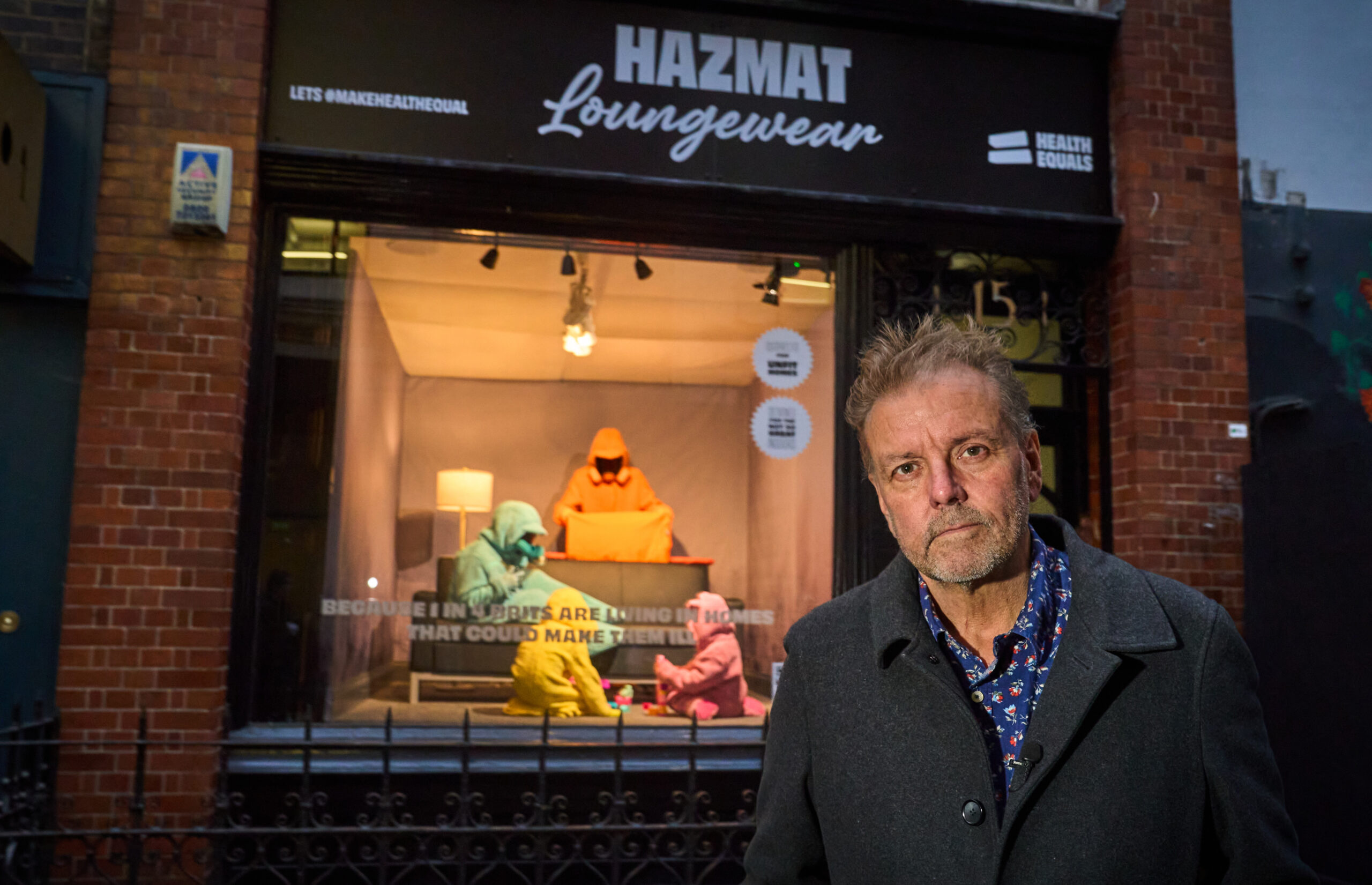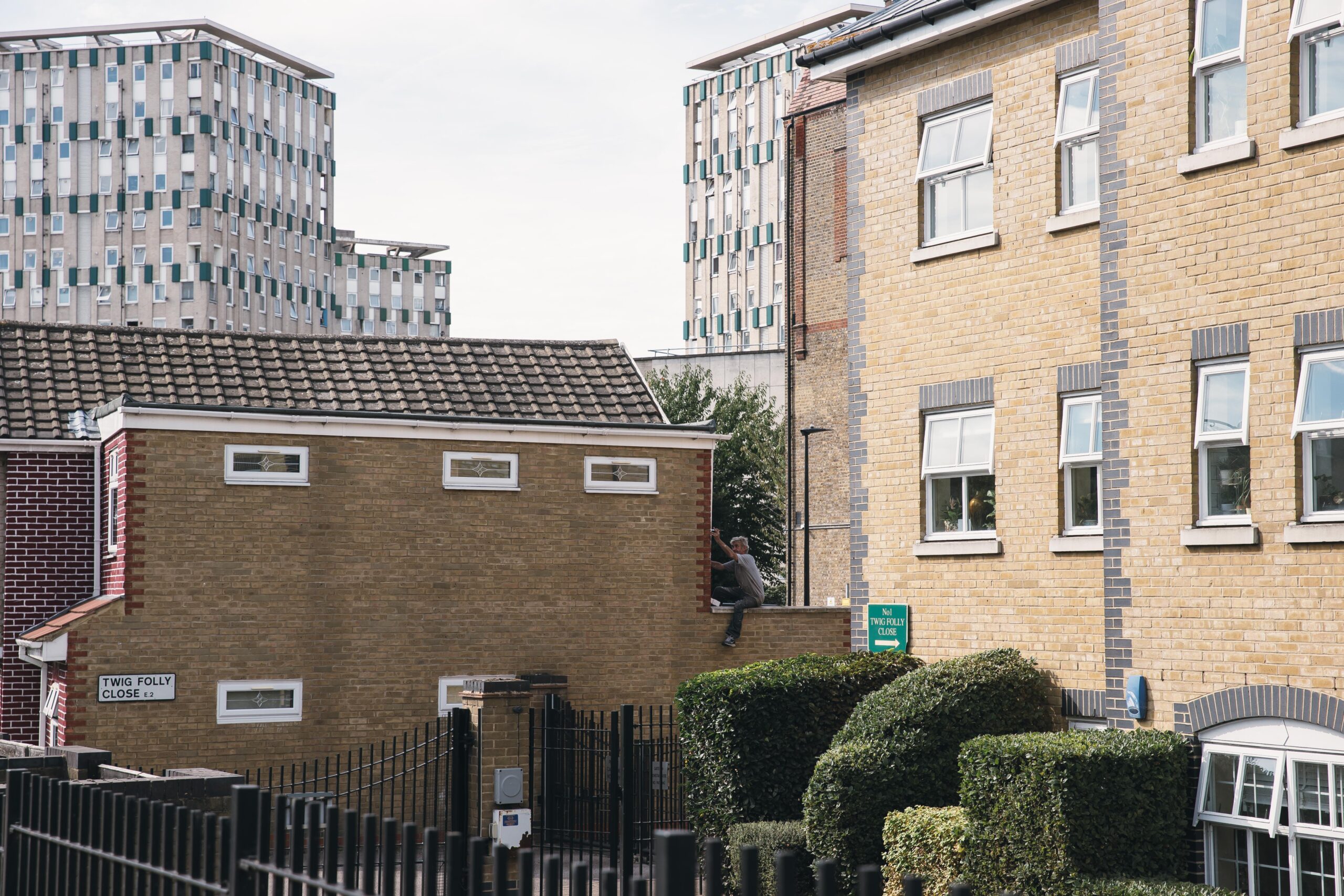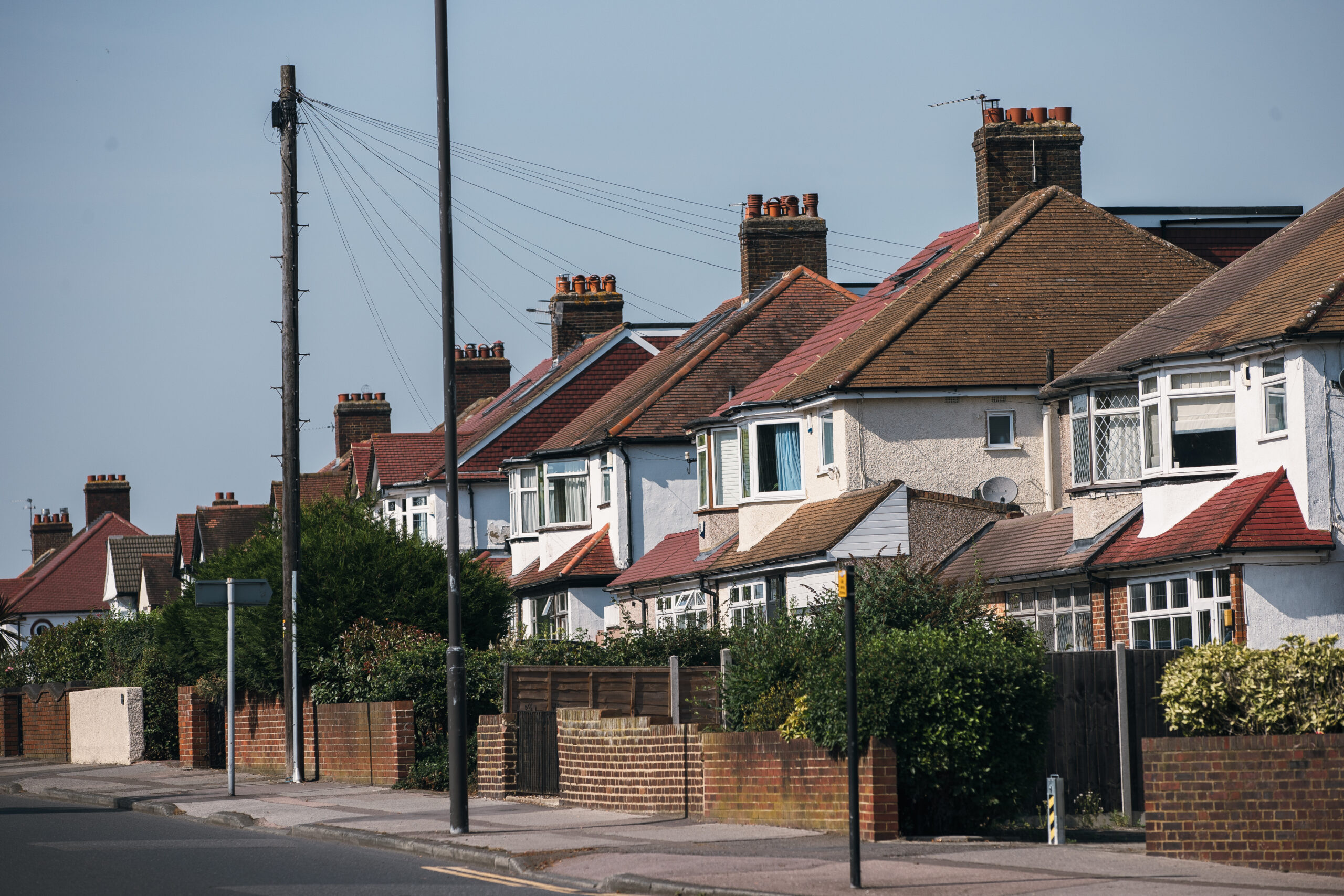Martin Roberts and Kwajo Tweneboa support campaign exposing hidden housing health crisis
- Health Equals, supported by TV property expert Martin Roberts and housing campaigner, Kwajo Tweneboa, launch Hazmat Loungewear pop up shop window in central London, to highlight the hidden health hazard that many Brits face in their homes.
- An estimated 3 million children in the UK are living in homes with issues like damp, mould or cold.
- Damp, mould and cold are known causes of respiratory and cardiovascular symptoms, depression and anxiety.
- Good quality homes are a key building block of our health. Health Equals and its members are calling for a cross-government health inequalities strategy to make health equal across the UK.
New research commissioned by Health Equals has suggested that an estimated 6 million families in the UK are living with issues like damp, cold, and mould in their homes*. Alarmingly, an estimated 3 million children are affected nationwide.
Joined by Homes Under the Hammer presenter and property expert, Martin Roberts, and housing activist Kwajo Tweneboa, Health Equals staged a striking public stunt in central London. As major high street stores launch their Christmas window displays, the public were greeted by a family in a mould-ridden shop window, wearing hazmat-style loungewear with heavy-duty respirators.
The scene uses the suits as an absurd solution to the very real problem millions of Brits face in their own homes, while also highlighting the deep inequalities that mean some people are much less likely to have a healthy home than others.
Health Equals’ message is clear – lives are being cut short in the UK by up to 16 years, fuelled by unequal access to the building blocks of good health: things like the air we breathe, the money in our pockets, the work we do, and the homes we live in.
The stunt follows Awaab’s law** coming into force for English social housing tenants and the Renters’ Rights Act*** receiving royal assent for English private rental tenants. However, campaigners warn that these changes won’t take affect for another decade under current plans.
Research from a nationally representative survey of 3,982 people in October 2025 commissioned by Health Equals, highlights a growing public concern about the physical impact of poor housing conditions. 91% of the population worry about the effects of damp, cold, and mould on health****, with 37% living with people who have underlying health conditions that may increase their vulnerability.
Only a quarter (26%) of respondents believe tenants or residents are responsible for tackling issues such as damp, cold, and mould. By contrast, over half (53%) think private landlords should maintain rented properties, and 48% say local councils and housing associations have a duty to manage these problems.
Three quarters (76%) of people in the UK agree that the government should implement a plan to prevent health inequalities*****.
TV property expert, Martin Roberts, said:
After more than two decades visiting thousands of homes across the UK, I’ve seen first-hand how damp, cold and mould can destroy both a property and the wellbeing of the people living in it. It’s not just unsightly, it’s in the very fabric of people’s properties as well as, more importantly, their health.
Too often I’ve walked into houses where families are forced to live in conditions that no one should accept – children sleeping in damp bedrooms, condensation dripping down walls, the smell of mould in the air. And sadly, these are not isolated cases; they’re alarmingly common.
Good housing is the foundation for good health. You can’t expect people to thrive if the very place they’re meant to feel safe is actually making them sick. That’s why I’m proud to support the Health Equals campaign; because everyone deserves to live in a warm, dry, safe and healthy home.
Housing campaigner, Kwajo Tweneboa, said:
Damp, mould and disrepair are symptoms of a much deeper inequality in this country. I’ve spent years meeting families who are trying to raise their children in homes that would fail even the most basic standards – properties that landlords or councils should have fixed long ago.
The truth is, we all know what’s causing this: years of neglect, underinvestment, and a lack of accountability. The people most affected are those with the least power to change it: low-income families, single parents, older people, and those in social housing. They’re paying the price for a broken system that has allowed poor-quality housing to become normalised.
That’s why the Health Equals campaign is so important. It doesn’t just highlight the problem; it’s demanding real change. Stronger laws to make every landlord take responsibility, proper funding to repair homes, and a cross-government plan to make sure no one’s health is determined by their postcode or income.
Dr Andy Whittamore, a practising GP and Clinical Lead at Asthma + Lung UK, member of Health Equals, said:
No one should have to live in a home that harms their health, yet as this new research shows, that is the reality for millions of people in the UK.
Living in damp or mouldy housing puts people living with chronic lung conditions like asthma and chronic obstructive pulmonary disease (COPD) at risk of life-threatening flare-ups and means they are more likely to need emergency care. Long-term exposure to mould can also cause lung conditions like asthma in previously healthy individuals.
It’s high time for urgent government action to protect the health of the most vulnerable people in our society, ensuring everyone can stay warm and well at home.
Paul McDonald, Chief Campaigns Officer at Health Equals, said:
Our research lays bare a health crisis hidden behind closed doors inside people’s homes. Millions are living with issues like damp, cold or mould; conditions proven to damage health and worsen chronic illnesses like asthma and heart disease.
The fact that millions of people would need protective clothing to feel safe inside their own homes is absurd, yet that’s the message our stunt has brought to life. This hidden health hazard is a grim reality for far too many.
A warm, dry, and healthy home isn’t a luxury, it’s a basic human right and is one of the building blocks of good health. But these building blocks don’t stack up for everyone. That’s why we need to see a cross-government health inequalities strategy that prioritises prevention, sets ambitious targets and makes better health a shared goal for every part of government.
Health Equals is also supporting its expert members in calling for the government to:
- Apply Awaab’s Law so all landlords must respond promptly to life-threatening hazards, not just social landlords.
- Phase in and enforce the Decent Home Standard across all private rented homes well before 2035, not from 2035 as currently planned. Renters shouldn’t have to live in unhealthy homes for another decade.
- Introduce the Warm Homes Plan to slash fuel poverty, improve warmth and repair homes for those most in need.
- Set a cross-government target to halve the number of ‘non-decent’ homes across all tenures and regions of the UK over the next decade.
Lives are being cut short by up to 16 years in parts of the UK. Damp, cold and mould in our homes is part of the problem.
Let’s #MakeHealthEqual.
NOTES
*28.24% of adults who carried out the survey who said “My home has problems with condensation, damp or mould” at D9 or answered “No” at Q2a ‘During the cold winter weather, can you normally keep comfortably warm in your living room? This equates to 15 million adults. The family estimation comes as a result of 82% of adults living in family (using this ONS data) with an average of 1.82 adults per family (using this ONS family bulletin). This equals 6 million families, then it was assumed half have children (also using ONS family bulletin).
** Awaab’s Law is a new legal requirement for English social housing landlords to fix reported damp and mould within strict time limits to prevent health risks like those that led to the death of two-year-old Awaab Ishak. This came into force on October 27th.
*** The Renters’ Rights Act will bring the Decent Homes Standard and Awaab’s Law into the private rented sector for the first time – but not until 2035 according to a government consultation. This was given Royal Assent on October 27th.
**** Slightly concerned’, ‘Moderately concerned’ and ‘Very concerned’ answers combined.
***** Slightly concerned’, ‘Moderately concerned’ and ‘Very concerned’ answers combined.
****** Agree’ and ‘Strongly agree’ answers combined







